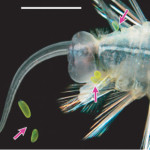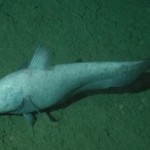Of all bony fish, the oarfish, Regalecus glesne, is the longest. It is suggested that oarfish can reach up to 15 meters (49 feet) in length but actual recorded lengths put them at still impressive 8 meters (26 feet). Oarfish will often was ashore or caught by fishermen. Yet, much like the giant squid, observations of oarfish alive in the wild are rare and video of them alive in the wild are even rarer.
Until now.
The SERPENT project (Scientific and Environmental ROV Partnership using Existing iNdustrial Technology) is a fruitful collaboration between marine researchers and the oil and gas industry. It provides scientific researchers access to industrial data and ROV resources at many locations. Both DELOS and SERPENT are resulting in advancements that would not otherwise be possible. With this new access to resources, deep-sea researchers and industry have an extraordinary opportunity to lead the way towards the informed use of deep-ocean resources and of course providing LIVE VIDEO OF OARFISH! ERMERGHERD! (or OARMERGHERD)
In a recent paper (boo closed access), not just one but five observations from ROV video are reported. The supplemental material, which I believe anyone can access, includes all five awesome videos. The best I have at the top (make sure you watch or continue to wach past the 5 minute mark). All the observations were from the Northern Gulf of Mexico and all of healthy fish. The depths of the observation range from 38.7 meters to 492.7 meters (127 -1616 feet). The authors suggest as well that “The absence of an immediate flight response by these individuals to the ROVsupports [the] hypothesis that R. glesne has few natural predators.”
UPDATE: I reported incorrectly this was the first video. The five videos were taken on 1/17/2008, 1/26/2008, 7/10/2008, 2/16/2009, and 8/15/2011. One of these videos was uploaded to Youtube and reported by Discovery on 2/9/10. Below is an earlier video uploaded on 7/28/2006 taken by scuba divers. Other videos do exist showing “live” oarfish near beaches but these are likely injured or sick individuals. So the videos from the paper clearly do appear to be the first but clearly this is still a rare event and great footage of enigmatic giant.
M. C. Benfield, S. Cook, S. Sharuga and M. M. Valentine Five in situ observations of live oarfish Regalecus glesne (Regalecidae) by remotely operated vehicles in the oceanic waters of the northern Gulf of Mexico Journal of Fish Biology. Article first published online: 5 JUN 2013 | DOI: 10.1111/jfb.12144






Kind of cool how they hang vertically in the water. Kind of like Cameron’s submersible profile.
GREAT!!!!!
A real seaserpent!
I have never seen a living oarfish.
What a phantastic Video.
[Jawdrop]
The cut off tail on the specimen in the video you posted would indicate they do have significant predators. That fish should have tapered off to a tiny tail fin. So it is missing what is probably a few feet of its hindquarters.
How long was that one? are they bioluminescent?
I run a private submersible and have recently been focusing more on HQ filming the animals of the deep, as it seems not enough people are doing so. A few months ago I had some customers that were ROV pilots from the North Sea off Norway, naturally we swapped “fish stories”. Despite my 4000 hours of diving, they told me of many things they had seen I had not, but when I asked how I could see these images, they told me the hard drives are on a 24 hour loop, and unless someone pulls the footage off them with in the day (which no one on the boat is getting paid to do) the footage is recorded over. It then became clear to us that more HQ deep sea footage has been gotten and deleted by the oil and gas companies than all the TV stations have ever had access to. The SERPENT program is an important step in the right direction to end this travesty.
Amazing. How exciting!!! I GASPED when I heard about this video. Thank you SO much for sharing. =)
(Tiny question, though. I thought the whale shark was the largest fish? They get up to 20 m, per http://www.flmnh.ufl.edu/fish/Gallery/Descript/whaleshark/whaleshark.html. Is this wrong?)
Beautiful… But perhaps not the first time it’s been recorded in the wild. There are at least a couple of videos on YouTube, like this one from 2006.
uh..but what about this one from 3 years ago?
http://www.youtube.com/watch?v=lvRqqwBoyx8
ah. I see. Same guy but 3 year old video.
This other oarfish video was posted 6 years ago :)
http://www.youtube.com/watch?v=XbeiVOFqQsc
Nice catch! All bony fish it meant to read
I am enchanted by it’s wavy locomotion. Is it following the ROV?
Such an amazing video !
By the way, when the camera zoom in at about 4:02 to the red crest of the oarfish. Is that some kind of parasite or just a structure from the crest itself ??
Hi Dr. M,
Great blog and thanks for spreading the word about the fascinating deepsea. However, I think you’ll want to return to the published article for some fact checking as the depth range you report for the authors’ observations is incorrect. Observations of oarfish in the study were made betweenn 38.7 – 492.7m, and not the “942 meteres to 1,844 meters (0.6 miles to 1.14 miles deep)” you have posted. In fact, the decidedly epi-pelagic to meso-pelagic nature of these observations and the fact that they reinforce that reported by Roberts 2012, but contradict the historical literature, is one of the big findings of the Benfield et al. paper. Thanks!
P.S. Oarfish have been observed alive in the wild — A LOT (you say otherwise in your intro: “Yet, much like the giant squid, we have never observed one alive in the wild. Until now.” That’s simply not true. Benfield et al. report some of the best observations of healthy oarfish — (most encounters are with distressed individuals found at the surface or dying or dead ones washed ashore) — but certainly nothing close to the first observations of live oarfish).
Rob,
Thanks for the corrections. I reported the wrong column from the table of reported depths. Instead of observed depth I reported the water depth. Nice catch. I have modified the other statements above.
That is EXACTLY what I just said!
When I was getting my undergrad in Marine Science, I guess I was a junior in 1997, Navy SEALS at Coranado, California found a washed up Oarfish that weighed excess of 300 lbs. It was a great photo of 15-20 SEAL recruits holding this massive long eel-like fish. Since then, I’ve been fascinated by these animals. What a great video capture of this animal in the wild, alive and whole. Very exciting.
There’s been a great book published last year called “Systematics, biology, and distribution of the species of the oceanic oarfish genus Regalecus” by Tyson Roberts (Memoirds du Museum National d’Histoire Naturelle). Packed with photographs and reproductions of ye olde plates as well as all the information about the two species known to date!! If you love this fish, get the book!:-D
The Whale Shark is part of the phylum Chrondichthyes, the cartilaginous fishes. He is not a bony fish since is squeleton is made of cartilage. You were right saying that the whale shark is the largest of all fish, but the regalek is the largest BONY fish.